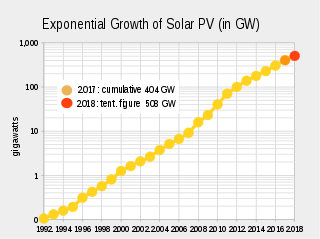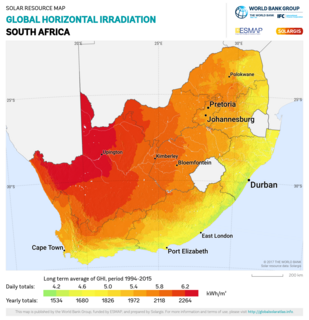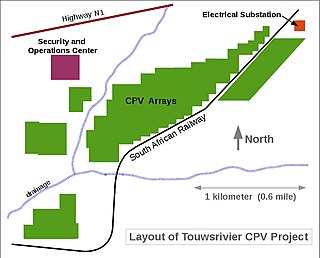| Industry | Solar Power Products |
|---|---|
| Defunct | 2014 |
| Fate | Bankruptcy |
| Headquarters | , |
Centrosolar, based in Munich, Germany, was one of the leading stock exchange listed solar companies in Europe. The company produced photovoltaic systems for private houses and industrial properties. Centrosolar marketed standard grid-connected systems and non-grid-connected solar power generators. [1]
In 2008, following 10 months of construction, Centrosolar opened a 47,000 square-meter, 150 MW solar module factory in Wismar, Germany. The €23 million facility has created 250 new jobs in Wismar. [2]
In 2014 the company declared bankruptcy. The German production facility was purchased by CS Wismar. [3] Centrosolars subsidiaries in France and The Netherlands were acquired by the German solar producer Solarwatt and continued business as Solarwatt France SARL and Solarwatt BV. [4]

Solar power in Australia is a fast growing industry. As of December 2020, Australia's over 2.66 million solar PV installations had a combined capacity of 20,198 MW photovoltaic (PV) solar power, of which at least 3,906 MW were installed in the preceding 12 months. In 2019, 59 solar PV projects with a combined capacity of 2,881 MW were either under construction, constructed or due to start construction having reached financial closure. Solar accounted for 9.9% of Australia's total electrical energy production in 2020.
BP Solar was a manufacturer and installer of photovoltaic solar cells headquartered in Madrid, Spain, with production facilities in Frederick, MD, India and the People's Republic of China. It was a subsidiary of BP.

Spain is one of the first countries to deploy large-scale solar photovoltaics, and as of 2018, is the first country for concentrated solar power (CSP) in the world.

Renewable energy commercialization involves the deployment of three generations of renewable energy technologies dating back more than 100 years. First-generation technologies, which are already mature and economically competitive, include biomass, hydroelectricity, geothermal power and heat. Second-generation technologies are market-ready and are being deployed at the present time; they include solar heating, photovoltaics, wind power, solar thermal power stations, and modern forms of bioenergy. Third-generation technologies require continued R&D efforts in order to make large contributions on a global scale and include advanced biomass gasification, hot-dry-rock geothermal power, and ocean energy. As of 2012, renewable energy accounts for about half of new nameplate electrical capacity installed and costs are continuing to fall.

First Solar, Inc. is an American manufacturer of solar panels, and a provider of utility-scale PV power plants and supporting services that include finance, construction, maintenance and end-of-life panel recycling.
For solar power, South Asia has the ideal combination of both high solar insolation and a high density of potential customers.

Solar power in Germany consists almost exclusively of photovoltaics (PV) and accounted for an estimated 8.2 percent of the country's gross-electricity generation in 2019. About 1.5 million photovoltaic systems were installed around the country in 2014, ranging from small rooftop systems, to medium commercial and large utility-scale solar parks. Germany's largest solar farms are located in Meuro, Neuhardenberg, and Templin with capacities over 100 MW.

Solar power represented a very small part of electricity production in the United Kingdom (UK) until the 2010s when it increased rapidly, thanks to feed-in tariff (FIT) subsidies and the falling cost of photovoltaic (PV) panels.

Solar power is the conversion of energy from sunlight into electricity, either directly using photovoltaics (PV), indirectly using concentrated solar power, or a combination. Concentrated solar power systems use lenses or mirrors and solar tracking systems to focus a large area of sunlight into a small beam. Photovoltaic cells convert light into an electric current using the photovoltaic effect.

A photovoltaic system, also PV system or solar power system, is a power system designed to supply usable solar power by means of photovoltaics. It consists of an arrangement of several components, including solar panels to absorb and convert sunlight into electricity, a solar inverter to convert the output from direct to alternating current, as well as mounting, cabling, and other electrical accessories to set up a working system. It may also use a solar tracking system to improve the system's overall performance and include an integrated battery solution, as prices for storage devices are expected to decline. Strictly speaking, a solar array only encompasses the ensemble of solar panels, the visible part of the PV system, and does not include all the other hardware, often summarized as balance of system (BOS). As PV systems convert light directly into electricity, they are not to be confused with other solar technologies, such as concentrated solar power or solar thermal, used for heating and cooling.

Worldwide growth of photovoltaics has been close to exponential between 1992 and 2018. During this period of time, photovoltaics (PV), also known as solar PV, evolved from a niche market of small-scale applications to a mainstream electricity source.

Solar power in California includes utility-scale solar power plants as well as local distributed generation, mostly from rooftop photovoltaics. It has been growing rapidly because of high insolation, community support, declining solar costs, and a Renewable Portfolio Standard which requires that 33% of California's electricity come from renewable resources by 2020, and 60% by 2030. Much of this is expected to come from solar power via photovoltaic facilities or concentrated solar power facilities.

A photovoltaic power station, also known as a solar park, solar farm, or solar power plant is a large-scale photovoltaic system designed for the supply of merchant power into the electricity grid. They are differentiated from most building-mounted and other decentralised solar power applications because they supply power at the utility level, rather than to a local user or users. The generic expression utility-scale solar is sometimes used to describe this type of project.

Solar power in South Africa includes photovoltaics (PV) as well as concentrated solar power (CSP). In 2016, South Africa had 1,329 MW of installed solar power capacity. Installed capacity is expected to reach 8,400 MW by 2030.

The Alamosa Solar Generating Plant is a 35.3 MWp (30.0 MWAC) concentrator photovoltaics (CPV) power station, the largest in the world when it was completed, in May 2012. It is currently the world's third largest operating CPV facility. The output is being sold to Public Service of Colorado, a subsidiary of Xcel Energy, under a long term Power Purchase Agreement.
In 2018 Chile produced about 7% of its electricity from solar power. As of year end, it had 2137 MW of solar PV capacity. In July 2020 installed solar capacity had risen to 3104 MW, with another 2801 MW under construction.

Grape Solar is a renewable energy company headquartered in Eugene, Oregon, which is dedicated to the manufacturing and marketing of solar photovoltaic modules. They manufacture solar power kits which are available from a number of retailers, including Home Depot, Costco, and Amazon. Grape solar was originally known as Centron Solar, but was forced to change its name after a lawsuit with German solar company Centrosolar.

Touwsrivier CPV Solar Project is a 44 MWp (36 MWAC) concentrator photovoltaics (CPV) power station located 13 km outside the town of Touwsrivier in the Western Cape of South Africa. The installation reached full capacity in December 2014 and is the second largest operating CPV facility in the world. Electricity produced by the plant is fed into the national grid operated by Eskom under a 20-year power purchase agreement (PPA).

The Bison Solar Plant, also known as the Rawhide Flats Solar Plant, is a 30 megawatt (MWAC) photovoltaic power station in Larimer County, Colorado located about 10 miles (16 km) north of the town of Wellington. The plant is notable for being one of the first in the U.S. built to a 1500 Volt system specification. The electricity is being sold to the Platte River Power Authority (PRPA) under a 25-year power purchase agreement.